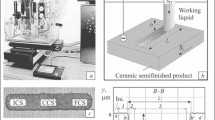Production features of micromachining ceramic workpieces using electrical-discharge machining are studied. The effect of pulse duration, breakdown voltage, voltage gain factor, peak current strength, and working voltage for electrical-discharge machining of VOK71 ceramic workpieces on roughness at the bottom of a channel and electrode-tool end wear are established. A mechanism is proposed for surface formation with electrical-discharge machining of current-conducting ceramic and recommendations are formulated for improving micromachining efficiency for components of this material.



Similar content being viewed by others
References
V. Kuzin, S. Grigoriev, S. Fedorov, and M. Fedorov, “Surface defects formation in grinding of silicon nitride ceramics,” Appl. Mechan. Mater., 752/753, 402 – 406 (2015).
T. R. Ablyaz, A. M. Khanov, and V. V. Sevast’yanov, “Features of electrical-discharge machining of small conmponents,” Vestn. Samar. Nauch. Tsentra RAN, 13(4), 935 – 938 (2011).
I. Puertas and C. J. Luis, “A study on the electrical discharge machining of conductive ceramics,” J. Materials Process. Technol., No. 153 / 154, 1033 – 1038 (2004).
L. Taichiu and D. Jianxin, “Mechanical surface treatments of electrodischarge machined (EDMed) ceramic composite for improved strength and reliability,” J. Europ. Ceram. Soc., 22, 545 – 550 (2002).
E. Ferraris, D. Reynaerts, and B. Lauwers, “Micro-EDM process investigation and comparison performance of Al2O3 and ZrO2 based ceramic composites,” CIRP Annals — Manufact. Technol., 60, 235 – 238 (2011).
K. Ho, S. T. Newman, S. Rahimifard, and R. D. Allen, “State of the art in wire electrical discharge machining (WEDM),” Internat. J. Machine Tools & Manufacture, 44, 1247 – 1259 (2004).
S. N. Grigor’ev, V. V. Kuzin, S. Yu. Fedorov, et al., “Technological aspects of the electrical-discharge machining of small-diameter holes in a high-density ceramic. Part 1,” Refract. Indust. Ceram., 55, 330 – 334 (2015).
S. N. Grigor’ev, V. V. Kuzin, S. Yu. Fedorov, et al., “Technological aspects of the electrical-discharge machining of small-diameter holes in a high-density ceramic. Part 2,” Refract. Indust. Ceram., 55, 469 – 472 (2015).
S. N. Grigor’ev, V. V. Kuzin, S. Yu. Fedorov, et al., “Technological aspects of the electrical-discharge machining of small-diameter holes in a high-density ceramic. Part 3,” Refract. Indust. Ceram., 55, 540 – 544 (2015).
V. V. Kuzin, S. Yu. Federov, Tibor Szalay, and Balázs Farkas, “Micromachining of a high-density current-conducting ceramic with the use of electrical-discharge machining. Part 1,” Novye Ogneupory, No. 3, 153 – 158 (2016).
B. N. Zolotykh, “Physical nature of electronic machining of metals,”Coll. TsNIL Élektron (B. R. Lazarenko, editor), Izd. Akad. Nauk SSSR (1957).
G. A. Gulyi, Scientific Bases of Pulsed Discharge Technology [in Russian] Naukova Dumka, Kiev (1990).
E. V. Krivitskii, Dynamics of Electrical Discharge in a Liquid [in Russian], Naukova Dumka, Kiev (1986).
P. P. Malyushevskii, Bases of Discharge Pulse Technology [in Russian], Naukova Dumka, Kiev (1983).
V. Ya. Ushakov, Pulsed Electrical Liquid Breakdown [In Russian], Izd. TPI, Tomsk (1975).
N. K. Foteev, Electrical-Discharge Machining Technology [in Russian] Mashinostroenie, Moscow (1980).
G. V. Samsonov and I. M. Mukha, “Features governing cathode wear during metal electrical-discharge machining,” Élektron. Obrab. Materialov., No. 3, 17 – 24 (1961).
G. V. Samsonov, I. M. Mukha, and A. N. Krushinskii, “Choice of electrode materials in electrical-discharge machining,” Élektron. Obrab. Materialov., No. 1, 28 – 32 (1966).
B. P. Saushkin, Physicochemical Machining Methods in Gas Turbine Engine Production [in Russian], Drofa, Moscow (2002).
Author information
Authors and Affiliations
Corresponding author
Additional information
Part 1 of the article published in Novye Ogneupory No. 3 (2016).
Translated from Novye Ogneupory, No. 5, pp. 58 – 62, May, 2016.
Rights and permissions
About this article
Cite this article
Kuzin, V.V., Fedorov, S.Y., Szalay, T. et al. Micromachining of a High-Density Current-Conducting Ceramic with the Use of Electrical-Discharge Machining. Part 2. Refract Ind Ceram 57, 283–287 (2016). https://doi.org/10.1007/s11148-016-9969-7
Received:
Published:
Issue Date:
DOI: https://doi.org/10.1007/s11148-016-9969-7




